New Energy Logistics Vehicle Promotion: A Tripartite Evolutionary Game Perspective
Abstract
1. Introduction
2. Literature Review
2.1. Research on Carbon Emission Reduction in the Logistics Industry
2.2. Application of Evolutionary Games in the Study of New Energy Vehicles
3. Evolutionary Game Model of New Energy Logistics Vehicles
3.1. Problem Description
3.2. Basic Assumptions
3.3. Model Development
3.4. Analysis of the Tripartite Evolutionary Game Model
3.4.1. The Expected Returns of the Three Parties Involved in the Game
- (1)
- For the government, the expected and average benefits of choosing to supervise and not supervise are, respectively:E11 = yz(−S − M − N) + y(1 − z)(−S − M − N) + (1 − y)z(L − M − N) + (1 − y)(1 − z)(L − M − N),E12 = yz * 0 + y(1 − z) (−G) + (1 − y)z * 0 + (1 − y)(1 − z)(−G),E1 = xE11 + (1 − x)E12.
- (2)
- For logistics vehicle enterprises, the expected and average benefits of choosing to produce NEVs and FVs are, respectively.E21 = xz[S + S1 + (R1 + ΔR) − (C1 + ΔC)] + x(1 − z)[S − (C1 + ΔC) + S1] + (1 − x)z[S1 + (R1 + ΔR) − (C1 + ΔC)]+ (1 − x)(1 − z)[S1 − (C1 + ΔC)],E22 = xz(−C1 − S2 − L) + x(1 − z)(R1 − C1 − S2 − L) + (1 − x)z(−C1 − S2) + (1 − x)(1 − z)(R1 − C1 − S2),E2 = yE21 + (1 − y)E22.
- (3)
- For logistics enterprises, the expected and average benefits of choosing to use NEVs and FVs are, respectively:E31 = xy[(Q1 + ΔQ) − (R1 + ΔR) + D − K] + x(1 − y)[(Q1 + ΔQ) − (R1 + ΔR) + D] + (1 − x)y[(Q1 + ΔQ) − (R1 + ΔR) − K]+(1 − x)(1 − y)[(Q1 +ΔQ) − (R1 + ΔR)],E32 = xy(Q1 − R1) + x(1 − y)(Q1 − R1) + (1 − x)y(Q1 − R1) + (1 − x)(1 − y)(Q1 − R1),E3 = zE31 + (1 − z)E32.
3.4.2. The Replication Dynamic Equation of the Three Parties
- (1)
- The replication dynamic equation of the government is obtained as:F1(x) = dx/dt = x(E11 − E1) = x(1 − x)(E11 − E12) = x(1 − x)[ (–L − S) * y + (1 − z) * G + L − M − N],
- (2)
- The replication dynamics equation for logistic vehicle enterprises is:F2(y) = dy/dt = y(E21 − E22) = y(1 − y)(E21 − E22) = y(1 − y)(Lx + 2R1z − R1 + Sx + S1 + S2 + zΔR − ΔC),
- (3)
- The replication dynamics equation for logistics enterprises is:F3(z) = dz/dt = z(E31 − E32) = z(1 − z)(E31 − E32) = z(1 − z)(Dx − Ky + ΔQ − ΔR),
3.4.3. Strategy Asymptotic Stability Analysis
- (1)
- Asymptotic stability analysis of the government’s gaming strategy
- i.
- If y = y*, F1(x) = 0 is constant. No matter how x changes, it will not affect the value of F1(x); that is, the government’s choice of game strategy is stable.
- ii.
- If y > y*, according to and , we can solve that x = 0 is an evolutionary stable point (ESP), that is, the government chooses not to supervise in a stable state and chooses to supervise in an unstable state.
- iii.
- If y < y*, according to and , we can solve that x = 1 is an ESP, that is, the government chooses to supervise in a stable state and chooses not to supervise in an unstable state. The replication dynamic phase diagram of the government is shown in Figure 2.
- (2)
- Asymptotic Stability Analysis of Game Strategies of Logistics Vehicle Enterprises
- i.
- If x = x*, F2(y) = 0 is constant, so no matter how y changes, it will not affect the value of F2(y). That is, the game strategy choice of logistics vehicle enterprises is in a stable state.
- ii.
- If x > x*, according to and , we can solve that y = 1 is an ESP, that is, the logistics vehicle enterprises choose to produce NEVs in a stable state and choose to produce FVs in an unstable state.
- iii.
- If x < x*, according to and , we can solve that y = 0 is an ESP, that is, the choice of logistics vehicle enterprises to produce FVs in a stable state, and the choice of producing NEVs in an unstable state.
- (3)
- Asymptotic Stability Analysis of Game Strategies of Logistics Enterprises
- i.
- If x = x*, F3(z) = 0 is constant. No matter how z changes, it will not affect the value of F3(z); that is, the game strategy selection of logistics enterprises is in a stable state.
- ii.
- If x > x*, according to and , we can solve that z = 1 is an ESP, that is, the logistics enterprises choose to use NEVs in a stable state and choose to use FVs in an unstable state.
- iii.
- If x < x*, according to and , we can solve that z = 0 is an ESP, that is, it is a stable state for logistics enterprises to choose to use FVs, and it is an unstable state to choose to use NEVs.
3.4.4. Jacobi Matrix Analysis
- (1)
- ΔQ − ΔR > 0, that is, the incremental benefit of using NEVs is greater than the incremental cost of using NEVs.
- (2)
- R1 + ΔR > ΔC, that is, the selling price of NEVs sold by logistics vehicle enterprises is greater than the incremental cost of producing NEVs.
- (1)
- Scenario 1: When ΔQ − ΔR − K < 0, ΔC + R1 − S1 − S2 < 0, and G < M + N − L, the ESP of the system is E3(0, 1, 0); that is, the incremental gain from the use of NEVs by logistics enterprises minus the cost saved from mass production is less than the incremental cost, logistics enterprises choose to use FVs; if the sum of the credit income obtained by logistics vehicle manufacturing enterprises from producing NEVs and the cost of purchasing positive credits that they don’t need to pay is greater than the income from selling FVs and the incremental cost of producing NEVs that they don’t need to pay, the logistics vehicle manufacturing enterprises will choose to produce NEVs. If the cost loss caused by the government’s non-supervision is less than the sum of the supervision cost, the road access right cost, and the fine revenue, the government will choose not to conduct supervision.
- (2)
- Scenario 2: when ΔQ − ΔR − K + D < 0, ΔC − L + R1 − S − S1 − S2 < 0 and G > M + N − L, the ESP of the system is E5(1, 1, 0); that is, the incremental revenue of logistics enterprises from using NEVs minus the cost saved by mass production plus the indirect revenue of road access rights is less than the incremental cost paid, so logistics enterprises choose to use FVs. When the credit income obtained by logistics vehicle manufacturing enterprises from producing NEVs, plus the government’s rewards to new energy vehicle manufacturing enterprises, minus the incremental cost of producing NEVs, is greater than the revenue from selling FVs minus the government’s fines for selling FVs minus the cost of purchasing positive credits, logistics vehicle manufacturing enterprises choose to produce NEVs. Since the cost loss caused by the government’s non-supervision is greater than the total supervision cost, the government chooses to conduct supervision.
- (3)
- Scenario 3: When ΔQ − ΔR − K > 0, the ESP of the system is E7(0, 1, 1); that is, the incremental revenue of logistics enterprises from using NEVs minus the cost saved through mass production is greater than the incremental cost. Therefore, logistics enterprises will also choose to use NEVs.
4. Numerical Simulation
4.1. Stability Point Simulation Analysis
4.2. Analysis of Key Parameters
4.2.1. The Impact of Incremental Costs (ΔC) of Logistics Vehicle Enterprises on System Evolution
4.2.2. The Impact of Logistics Vehicle Enterprises Points Gain (S1) on System Evolution
4.2.3. The Impact of Incremental Costs (ΔR) of Logistics Enterprises on System Evolution
4.2.4. The Impact of Government Fines (L) on the System Evolution of Logistics Vehicle Enterprises
5. Conclusions and Recommendations
5.1. Conclusions
- (1)
- The tripartite game’s ideal stability strategy combination is (0, 1, 1), which describes {no government supervision, logistics vehicle enterprises produce NEVs, logistics enterprises use NEVs}.
- (2)
- When the incremental cost of producing NEVs by logistics vehicle enterprises is controllable, the government is inclined to employ a lenient regulatory policy. In this case, logistics vehicle enterprises are more willing to commit to producing NEVs. At the same time, due to the potential profits that the right-of-way policy may bring, logistics enterprises are also more inclined to adopt and use NEVs.
- (3)
- An increase in the dual-credit gain has a pronounced effect on motivating logistics vehicle enterprises to produce NEVs. Nevertheless, the rate at which logistics enterprises adopt NEVs continues to be restricted by cost-related factors.
- (4)
- When the cost (ΔR) of using NEVs rises for logistics enterprises, they may reconsider using FVs. In the face of environmental pollution problems, the government will be more likely to increase its supervision. Logistics vehicle enterprises will tend to produce NEVs to obtain government incentives.
- (5)
- With government incentives remaining unchanged and fines increasing, the probability of initial government oversight will increase. This will prompt logistics vehicle enterprises to transform and increase the production of NEVs rapidly. At the same time, logistics enterprises will accelerate the pace of NEVs.
5.2. Recommendations
- (1)
- Multi-dimensionally encourage logistics enterprises to adopt NEVs. The government can give NEVs more right-of-way, optimize the layout of charging facilities, reduce or waive road tolls, and implement other preferential policies to stimulate logistics enterprises to buy NEVs and increase their willingness to use them.
- (2)
- Optimize the DCP and increase the value of points trading. The DCP has a positive regulatory impact on advancing the NEV industry, and the government should continue to optimize the relevant policies and appropriately increase the value of NEV points to motivate logistics vehicle enterprises to produce more NEVs to make up for the cost increase.
- (3)
- Promote the cost reduction of NEVs and enhance market competitiveness. Encourage logistics vehicle enterprises to reduce the production cost of NEVs through technological innovation, research, and development of new batteries, scale effect, energy management optimization, and other means to make them more competitive in the market, thus making them more motivated to use NEVs. Moreover, long-term cost management should be prioritized by considering battery disposal expenses. Develop a standardized, efficient battery recycling system, invest in R&D, and boost recycling rates and resource conversion efficiency to cut retired battery disposal costs.
- (4)
- Appropriate policy support to reduce the incremental cost of NEVs. Give NEV enterprises certain incentives (tax incentives, negative points reduction, transfer, carry-over, etc.) in the early stage of subsidy degradation and increase penalties for enterprises producing FVs when necessary, which will help to make up for the production cost of the vehicle enterprises, incentivize the production of NEVs by logistics vehicle enterprises, and help encourage the logistics sector’s shift toward a low-carbon future.
Author Contributions
Funding
Institutional Review Board Statement
Informed Consent Statement
Data Availability Statement
Conflicts of Interest
References
- He, L.Y.; Yin, F.; Zhong, Z.Q.; Ding, Z.H. The impact of local government investment on the carbon emissions reduction effect: An empirical analysis of panel data from 30 provinces and municipalities in China. PLoS ONE 2017, 12, e0180946. [Google Scholar] [CrossRef]
- Wang, Q.; Feng, Y.; Hu, A. Optimal utilization of ecological economic resources and low-carbon economic analysis from the perspective of Public Health. Front. Public Health 2023, 11, 1152809. [Google Scholar] [CrossRef] [PubMed]
- China Federation of Logistics and Purchasing. China Green Logistics Development Report (2023); China Federation of Logistics and Purchasing: Beijing, China, 2023. [Google Scholar]
- Intelligent Research Consulting. Available online: https://www.chyxx.com/ (accessed on 19 November 2024).
- Liu, L.H.; Wu, Y.L.; Liu, S.Q.; Chen, Z.X. Equilibrium study of logistics demand and logistics resource allocation in Guangdong Province. Sci. Rep. 2025, 15, 3805. [Google Scholar] [CrossRef] [PubMed]
- Song, R.; Shi, W.; Qin, W.; Xue, X. Exploring the interplay of new energy vehicle enterprises, consumers, and government in the context of the “dual carbon” target: An evolutionary game and simulation analysis. PLoS ONE 2023, 18, e0291175. [Google Scholar] [CrossRef] [PubMed]
- Xue, H.T.; Song, Z.W.; Wu, M.; Sun, N.; Wang, H.Q. Intelligent Diagnosis Based on Double-Optimized Artificial Hydrocarbon Networks for Mechanical Faults of In-Wheel Motor. Sensors 2022, 22, 6316. [Google Scholar] [CrossRef]
- KBA-Kraftfahrt-Bundesamt. Available online: https://www.kba.de/EN/Home/home_node.html (accessed on 19 November 2024).
- Chen, L.X.; Huang, J.Y. Study on the Interaction Effect between the Intensity of Government Low-Carbon Subsidies and the Growth Ability of Green and Low-Carbon Emerging Enterprises. Int. J. Environ. Res. Public Health 2023, 20, 2438. [Google Scholar] [CrossRef]
- Cai, D.; Guo, C.; Tan, Y. Design of Incentive Contract for Technological Innovation of New Energy Vehicles with Asymmetric Information. Int. J. Environ. Res. Public Health 2019, 16, 4544. [Google Scholar] [CrossRef]
- Yu, Y.; Zhou, D.; Zha, D.; Wang, Q.; Zhu, Q. Optimal production and pricing strategies in auto supply chain when dual credit policy is substituted for subsidy policy. Energy 2021, 226, 120369. [Google Scholar] [CrossRef]
- Zhang, X.; Hu, X.M.; Qi, L. Terminated Local Subsidy on Electric Vehicle Adoption during the COVID-19 Pandemic: The Case of Chongqing City. Energy 2022, 259, 124891. [Google Scholar] [CrossRef]
- Chinese Government Website. Available online: https://www.gov.cn/ (accessed on 20 November 2024).
- Yu, H.; Li, Y.; Wang, W. Does the Dual-Credit Policy Promote the Technological Development of New Energy Vehicles? An Industry Chain Reconstruction Perspective. Heliyon 2024, 10, e31009. [Google Scholar] [CrossRef]
- Wang, J.L.; Liu, X.B. Research on the Development Strategy Selection of the New Energy Vehicle Industry from the Perspective of Green Credit—Based on the Foursquare Evolutionary Game Analysis. PLoS ONE 2024, 19, e0297813. [Google Scholar] [CrossRef] [PubMed]
- Fan, W.; Gao, B. How State-Owned Vehicle Enterprises Face the Disruptive Technological Revolution—The Case of SAIC. Culture 2024, 2, 90–100. [Google Scholar]
- Wu, S.S.; Gong, X.; Wang, Y.F.; Cao, J. Consumer Cognition and Management Perspective on Express Packaging Pollution. Int. J. Environ. Res. Public Health 2022, 19, 4895. [Google Scholar] [CrossRef] [PubMed]
- Li, C.; Zhang, Z.C.; Wang, L.P. Carbon Peak Forecast and Low Carbon Policy Choice of Transportation Industry in China: Scenario Prediction Based on STIRPAT Model. Environ. Sci. Pollut. Res. 2023, 30, 63250–63271. [Google Scholar] [CrossRef]
- Ren, T.; Chen, Y.; Xiang, Y.C.; Xing, L.N.; Li, S.D. Low Carbon Cold Chain Vehicle Path Optimization Considering Customer Satisfaction. CIMS 2020, 26, 1108–1117. [Google Scholar]
- Yin, N. Multiobjective Optimization for Vehicle Routing Optimization Problem in Low-Carbon Intelligent Transportation. IEEE Trans. Intell. Transp. Syst. 2023, 24, 13161–13170. [Google Scholar] [CrossRef]
- Wang, Y.; Zhou, X.; Liu, Y.; Xu, M.Z. Optimization of multi-center co-distribution alliance based on vehicle sharing. CIMS 2021, 27, 1820–1832. [Google Scholar]
- Liu, W.; Li, W.; Zhou, Q.; Die, Q.; Yang, Y. The optimization of the “UAV-vehicle” joint delivery route considering mountainous cities. PLoS ONE 2022, 17, e0265518. [Google Scholar] [CrossRef]
- Zhang, S.Y.; Chen, N.; Song, X.M.; Yang, J. Optimizing decision-making of regional cold chain logistics system in view of low-carbon economy. Transp. Res. Part A Policy Pract. 2019, 130, 844–857. [Google Scholar] [CrossRef]
- Zhang, W.; Zhang, M.Y.; Zhang, W.Y.; Zhou, Q.; Zhang, X.X. What Influences the Effectiveness of Green Logistics Policies? A Grounded Theory Analysis. Sci. Total Environ. 2020, 71, 136731. [Google Scholar] [CrossRef]
- Han, X.B.; Han, Y.; Ke, R.; Zhao, J.H. Research on the Cooperation Model of New Energy Vehicle Supply Chain under the Background of Government Subsidies Declining. Sustainability 2022, 14, 12731. [Google Scholar] [CrossRef]
- Hu, J.; Wu, J.; Zhuang, F.; Wang, M.Z. Contract selection for collaborative innovation in the new energy vehicle supply chain under the dual credit policy: Cost sharing and benefit sharing. Int. J. Ind. Eng. Comput. 2024, 15, 209–222. [Google Scholar] [CrossRef]
- Shanmuganathan, J.; Victoire, A.A.; Balraj, G.; Victoire, A. Deep Learning LSTM Recurrent Neural Network Model for Prediction of Electric Vehicle Charging Demand. Sustainability 2022, 14, 10207. [Google Scholar] [CrossRef]
- Swain, D.; Kumar, M.; Nour, A.; Patel, K.; Bhatt, A.; Acharya, B.; Bostani, A. Remaining Useful Life Predictor for EV Batteries Using Machine Learning. IEEE Access 2024, 12, 134418–134426. [Google Scholar] [CrossRef]
- Yang, Y.; Zhang, Y.; Meng, X. A Data-Driven Approach for Optimizing the EV Charging Stations Network. IEEE Access 2020, 8, 118572–118592. [Google Scholar] [CrossRef]
- Xu, Y.; Han, L.Z.; Zhu, T.Y.; Sun, L.L.; Du, B.W.; Lv, W.F. Continuous-Time and Discrete-Time Representation Learning for Origin-Destination Demand Prediction. IEEE Trans. Intell. Transp. Syst. 2024, 25, 2382–2393. [Google Scholar] [CrossRef]
- Wu, B.; Liu, P.F.; Xu, X.F. An evolutionary analysis of low-carbon strategies based on the government-enterprise game in the complex network context. J. Clean. Prod. 2017, 141, 168–179. [Google Scholar] [CrossRef]
- Zhou, Y.; He, H.; Wang, Y.F. Low-Carbon Selection Decision for Logistics Enterprises Based on Evolutionary Game under the Supervision of Government. Adv. Mater. Res. 2011, 219–220, 736–741. [Google Scholar] [CrossRef]
- Li, L.H.; Wang, Y.; Deng, Y.J.; Nan, T.J. A three-party evolutionary game of green logistics development under carbon tax policy. J. Railw. Sci. Eng. 2023, 20, 3715–3726. [Google Scholar]
- Zheng, P.; Pei, W.J.; Pan, W.B. Impact of different carbon tax conditions on the behavioral strategies of new energy vehicle manufacturers and governments-A dynamic analysis and simulation based on prospect theory. J. Clean. Prod. 2023, 407, 137132. [Google Scholar] [CrossRef]
- Cai, R.; Zhang, T.; Wang, X.; Jia, Q.; Zhao, S.; Liu, N.; Wang, X. Evolutionary Game and Simulation Analysis of New-Energy Vehicle Promotion in China Based on Reward and Punishment Mechanisms. Mathematics 2024, 12, 2900. [Google Scholar] [CrossRef]
- Liu, C.; Liu, Z.; Li, W.; Xu, M. A time-delayed evolutionary game analysis of new energy vehicles development considering subsidy and carbon tax. Heliyon 2024, 10, e25667. [Google Scholar] [CrossRef] [PubMed]
- Liao, D.S.; Tan, B.B. An evolutionary game analysis of new energy vehicles promotion considering carbon tax in post-subsidy era. Energy 2023, 264, 126156. [Google Scholar] [CrossRef]
- Liu, C.; Song, Y.; Wang, W.; Shi, X. The governance of manufacturers’ greenwashing behaviors: A tripartite evolutionary game analysis of electric vehicles. Appl. Energy 2023, 333, 120498. [Google Scholar] [CrossRef]
- Jin, T.; Jiang, Y.L.; Liu, X.W. Evolutionary game analysis of the impact of dynamic dual credit policy on new energy vehicles after subsidy cancellation. Appl. Math. Comput. 2023, 440, 127677. [Google Scholar] [CrossRef]
- Zhang, G.S.; Wang, X.; Wang, Y.L.; Xu, J.Q. A tripartite evolutionary game for the regional green logistics: The roles of government subsidy and platform’ s cost-sharing. Kybernetes 2024, 53, 216–237. [Google Scholar] [CrossRef]
- Wang, X.J.; Quan, J.; Liu, W.B. Study on evolutionary games and cooperation mechanism within the framework of bounded rationality. Syst. Eng. Theory Pract. 2011, 31, 82–93. [Google Scholar]
- Guo, B.; Li, Y.X.; Wang, X.P. Steady-State Analysis of Social Responsibility Strategy of Coal Power Enterprises from the Perspective of Game Theory. Heliyon 2024, 10, e23124. [Google Scholar] [CrossRef]
- Tang, J.; Wu, Q. Fast or stable: Research on dynamic behaviors of duopoly automakers under the background of energy transformation in the automobile industry. Heliyon 2024, 10, e27711. [Google Scholar] [CrossRef]
- Cirillo, C.; Liu, Y.; Maness, M. A time-dependent stated preference approach to measuring vehicle type preferences and market elasticity of conventional and green vehicles. Transp. Res. Part A Policy Pract. 2017, 100, 294–310. [Google Scholar] [CrossRef]
- Wu, J.M.; Qian, J.L. Evolutionary game study of collaborative innovation among new energy vehicle enterprises, traditional vehicle enterprises, and government under the double integral policy. J. Technol. Econom 2024, 43, 22–32. [Google Scholar]
- Ritzberger, K.; Weibull, J.W. Evolutionary selection in normal-from game. Econometrica 1995, 63, 1371–1399. [Google Scholar] [CrossRef]
- Selten, R. A note on evolutionarily stable strategies in asymmetric animal conflicts. J. Theor. Biol. 1980, 84, 93–101. [Google Scholar] [CrossRef] [PubMed]
- Zhang, M.K.; Huang, Y.; Jin, Y.F.; Bao, Y. Government regulation strategy, leading firms’ innovation strategy, and following firms imitation strategy: An analysis based on evolutionary game theory. PLoS ONE 2023, 18, e0286730. [Google Scholar] [CrossRef] [PubMed]
- Zang, J.H.; Li, C.L. Interpretation of Adjustments to the Development Plan for New Energy Vehicle Industry (2021–2035). Automot. Manuf. Eng. 2021, 32–34. [Google Scholar] [CrossRef]
- Xing, Z. Research on New Energy Vehicle Industry Policy in Post-Subsidy Era. Master’s Thesis, Huazhong University of Science and Technology, Wuhan, China, 2023. [Google Scholar]
- Liu, Q.M. A Simulation Study on Game and Benefit Optimization in the Replacement Process of New and Old Energy Logistics Vehicles. Ph.D. Thesis, Beijing Jiaotong University, Beijing, China, 2021. [Google Scholar]
- China Society of Automotive Engineers (CSAE). Technology Roadmap for Energy Saving and New Energy Vehicles 2.0, 2nd ed.; China Machine Press: Beijing, China, 2020. [Google Scholar]
- CATL. Annual Technology Roadmap 2025. Available online: https://www.catl.com/en/news/665.html (accessed on 10 July 2025).
- China Association of Automobile Manufacturers; China Automotive Engineering Research Institute Co., Ltd.; FAW Jiefang Group Co., Ltd. Annual Report on the Development of China’s Commercial Vehicle Industry (2024); Social Sciences Academic Press: Beijing, China, 2024. [Google Scholar]
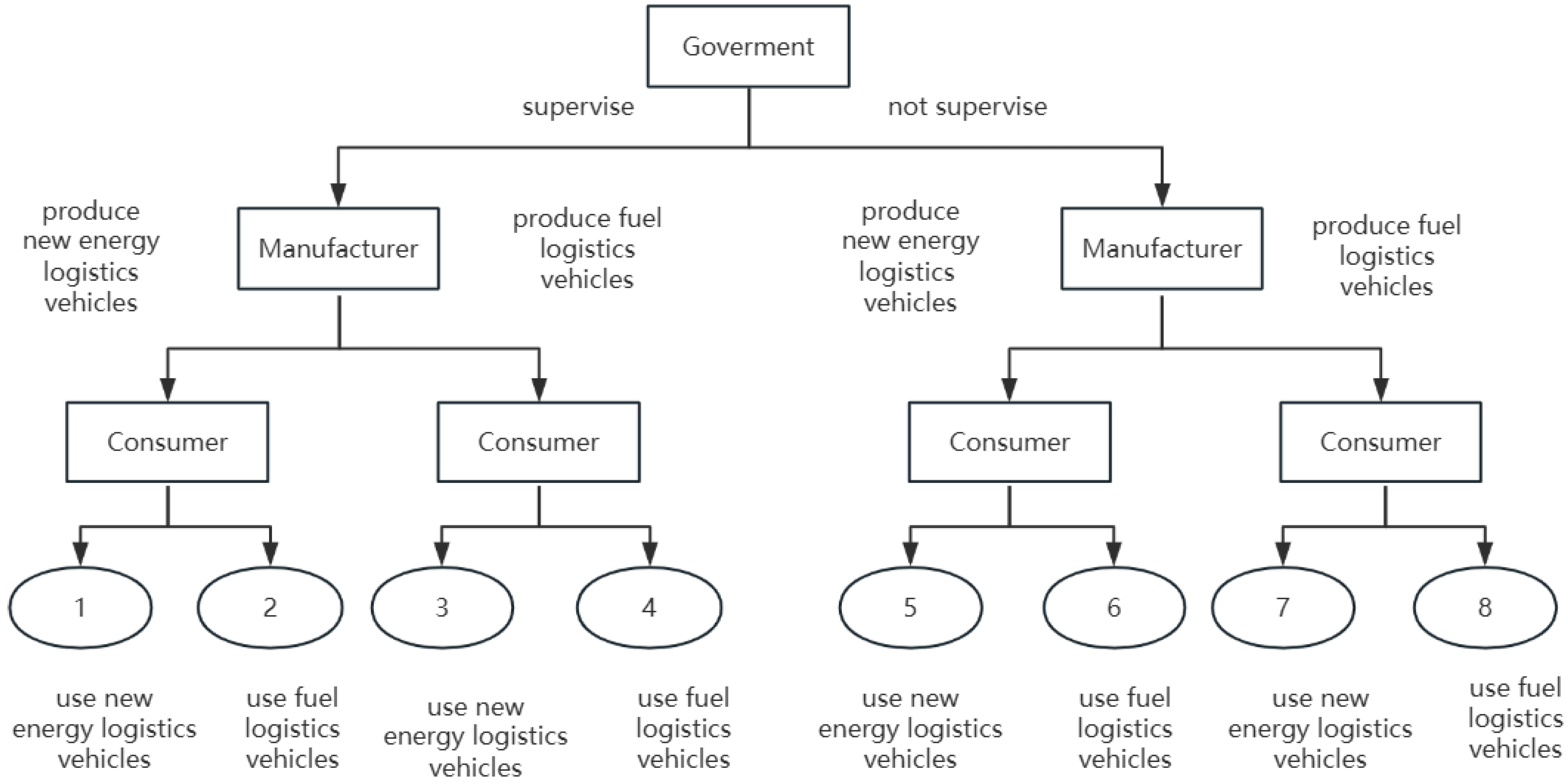


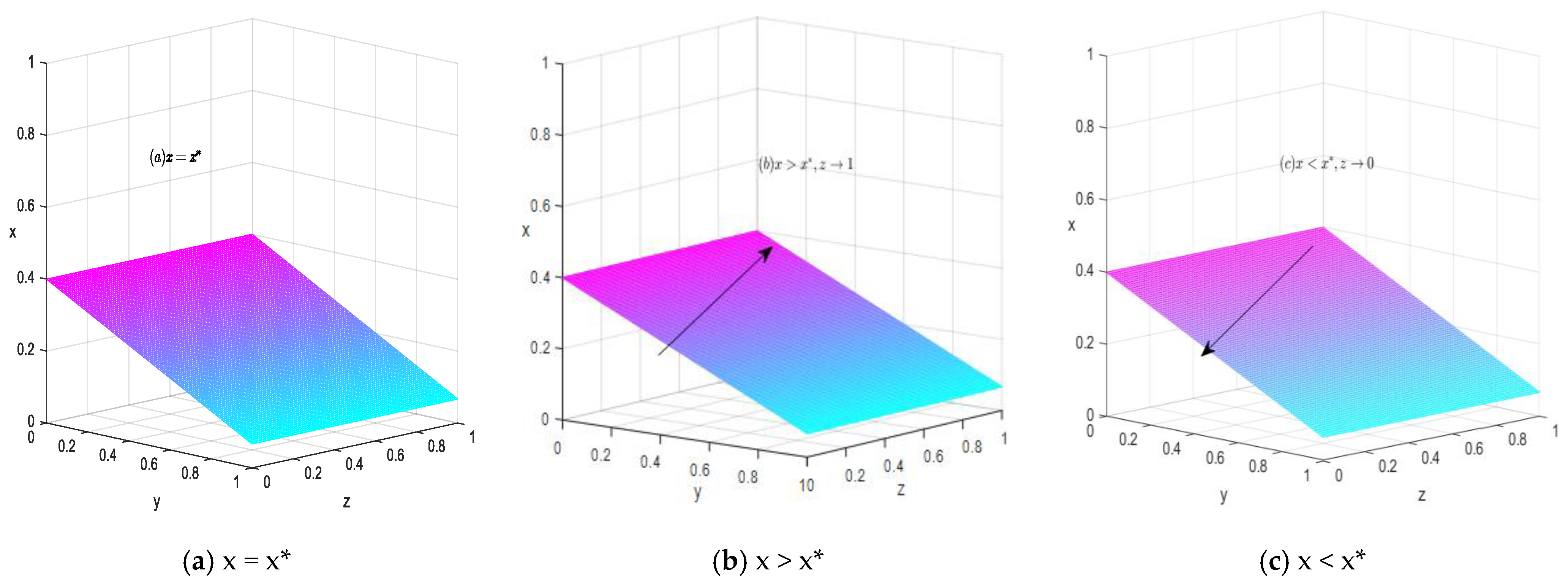



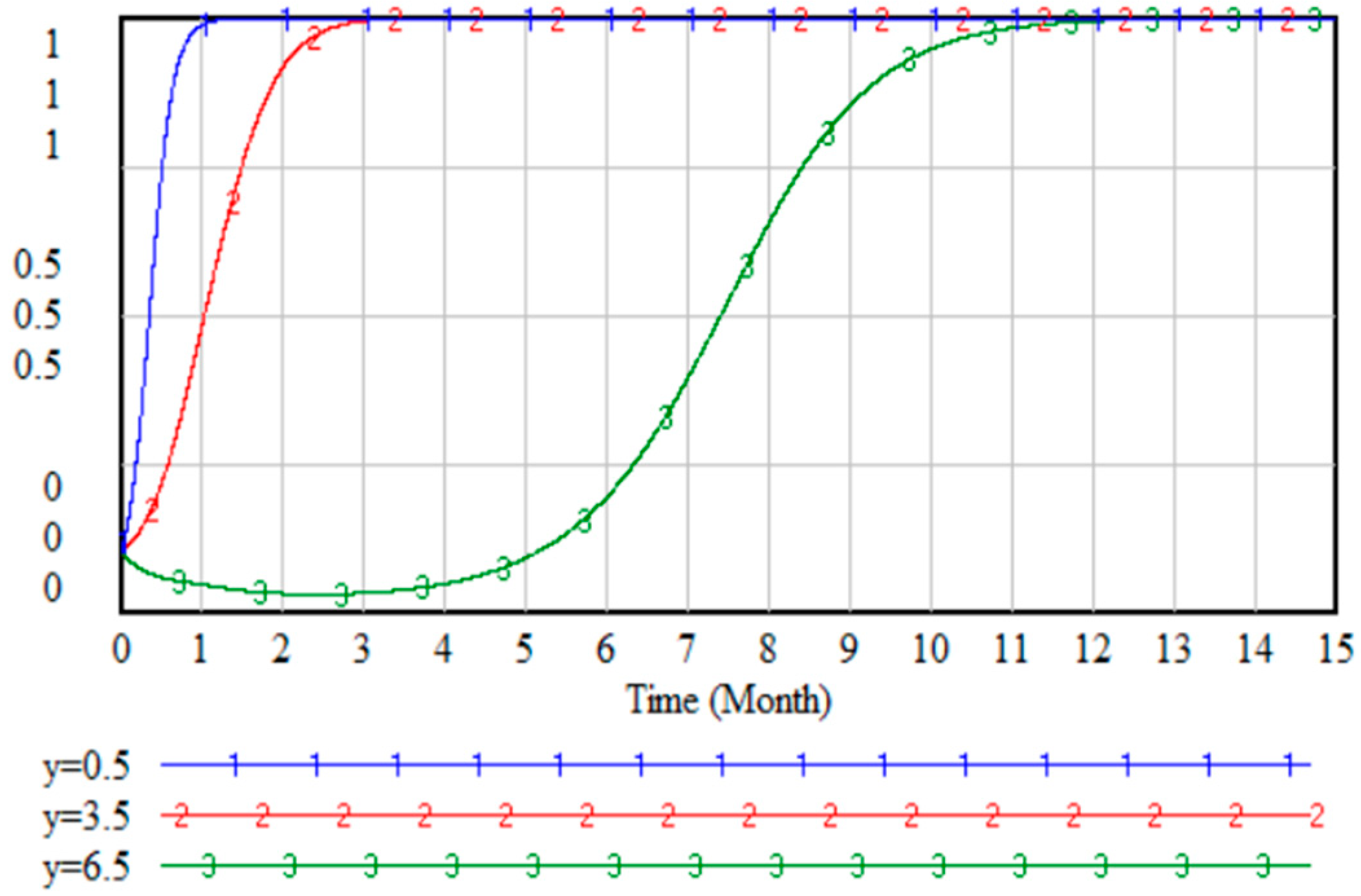
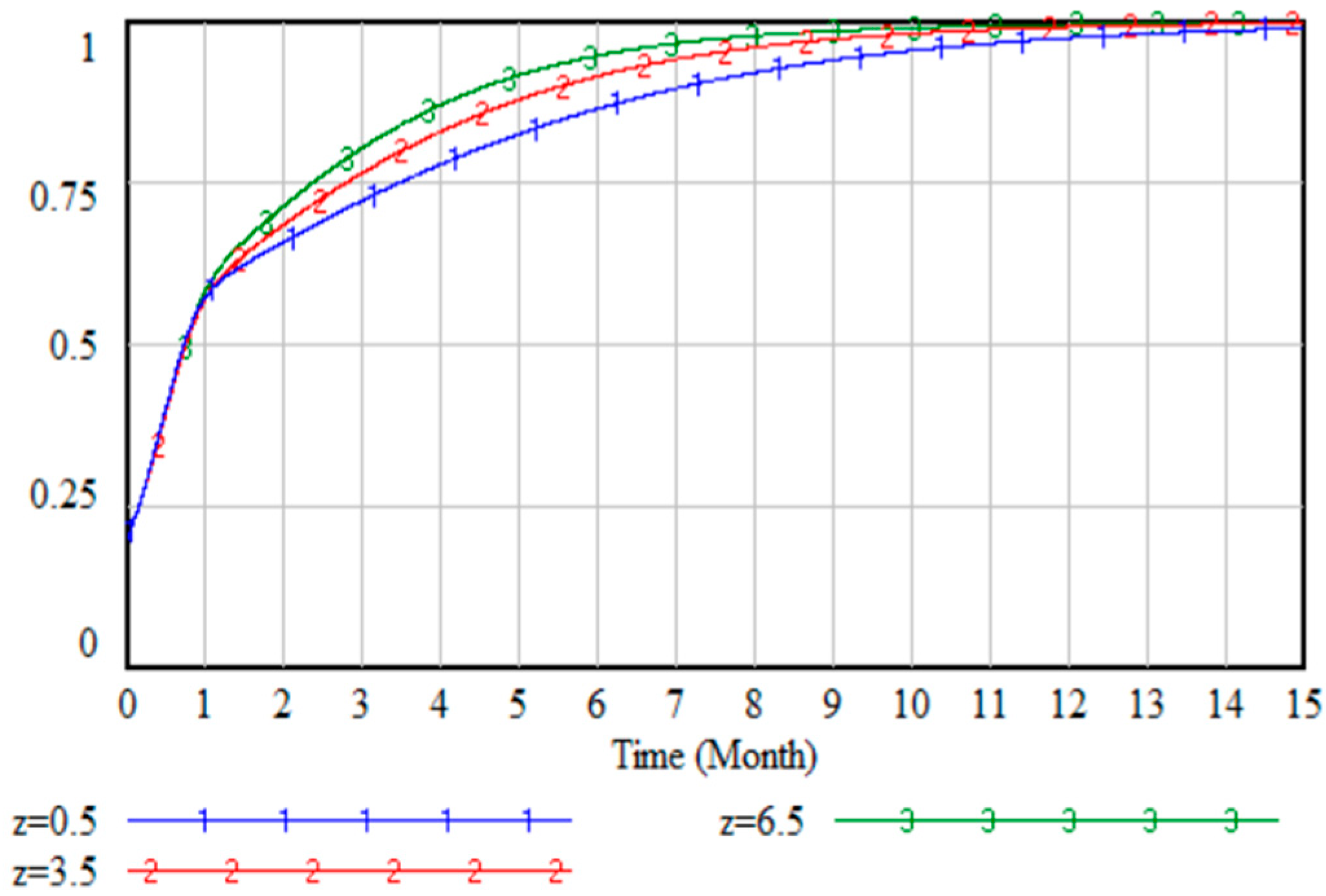

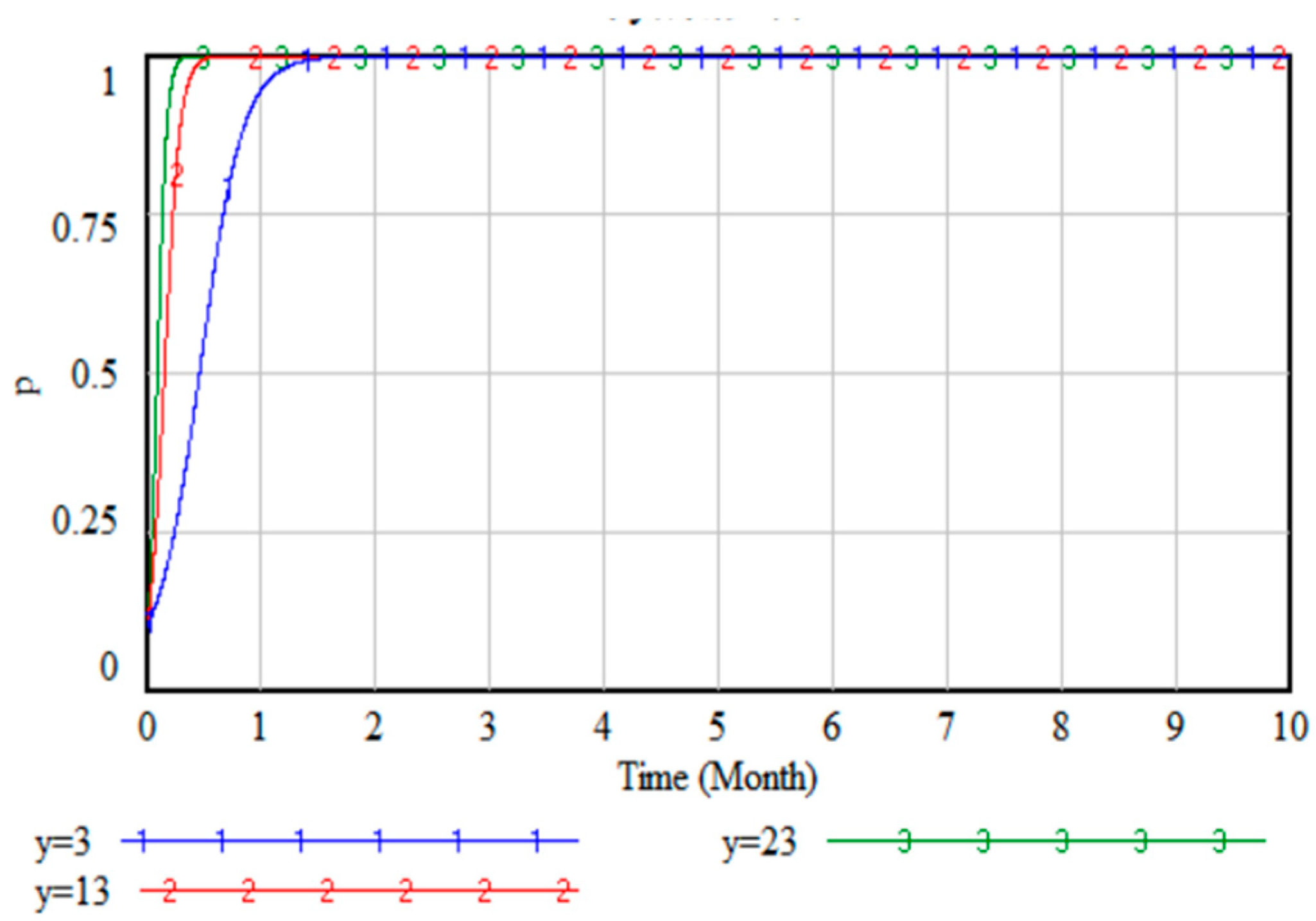
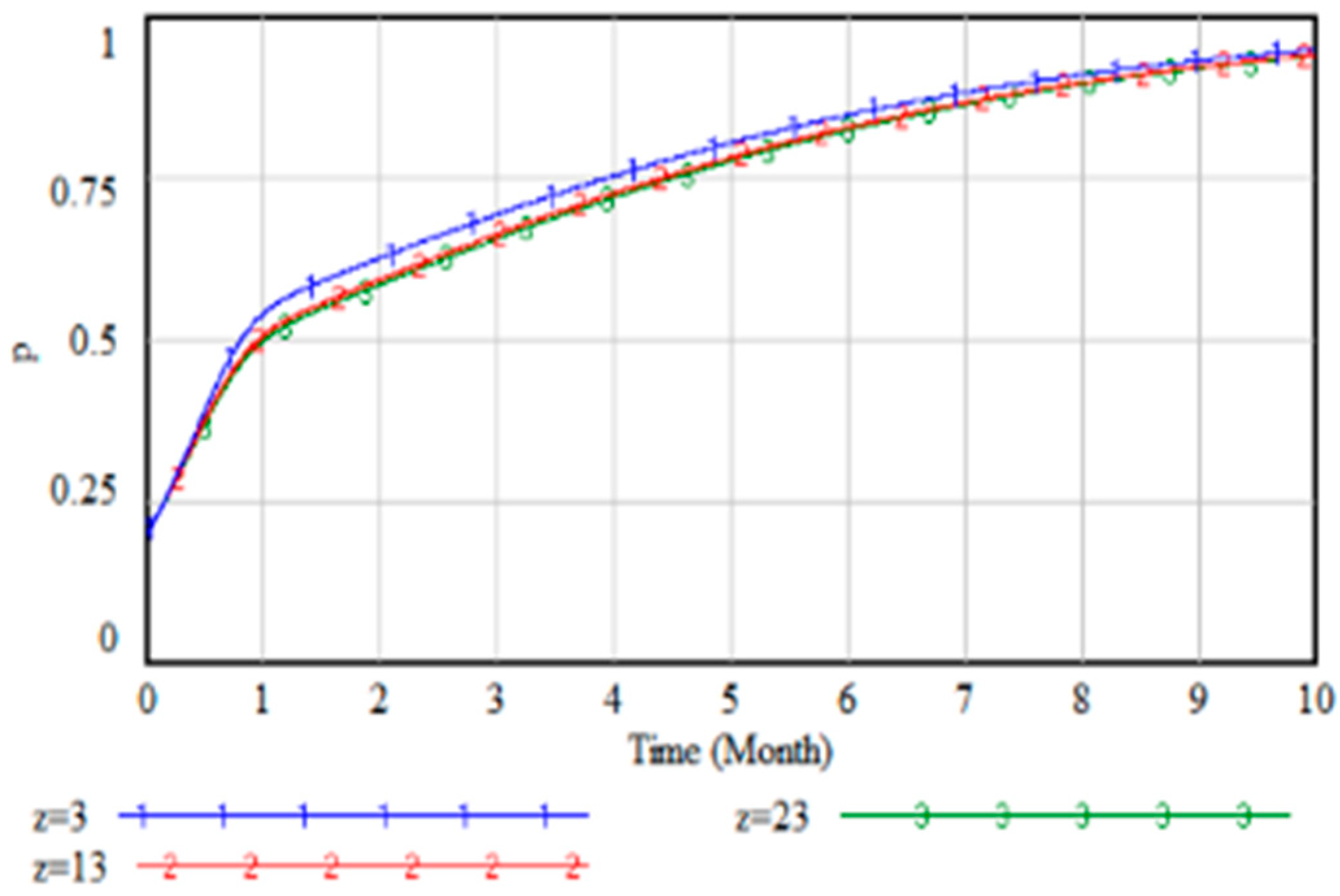
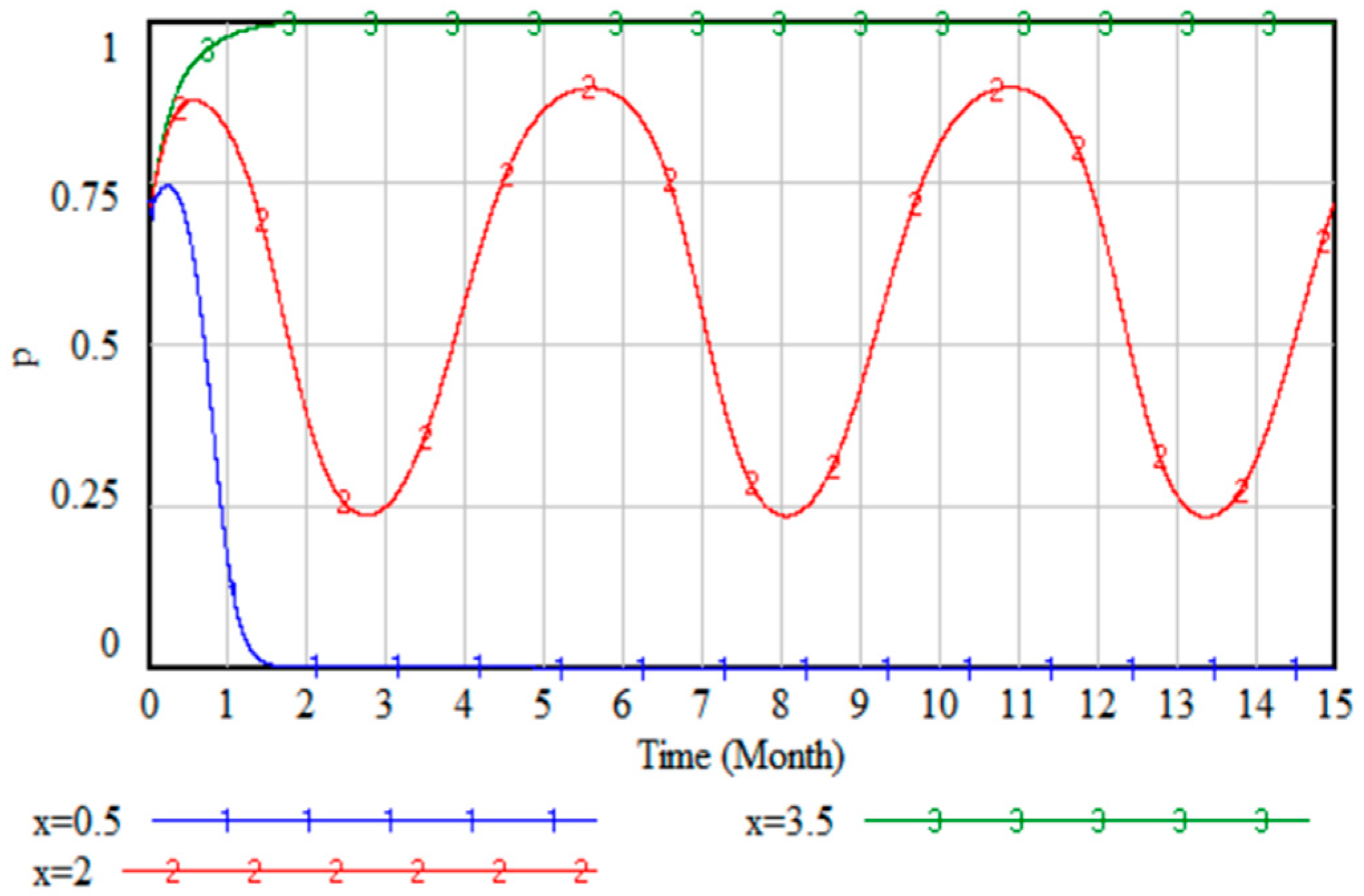

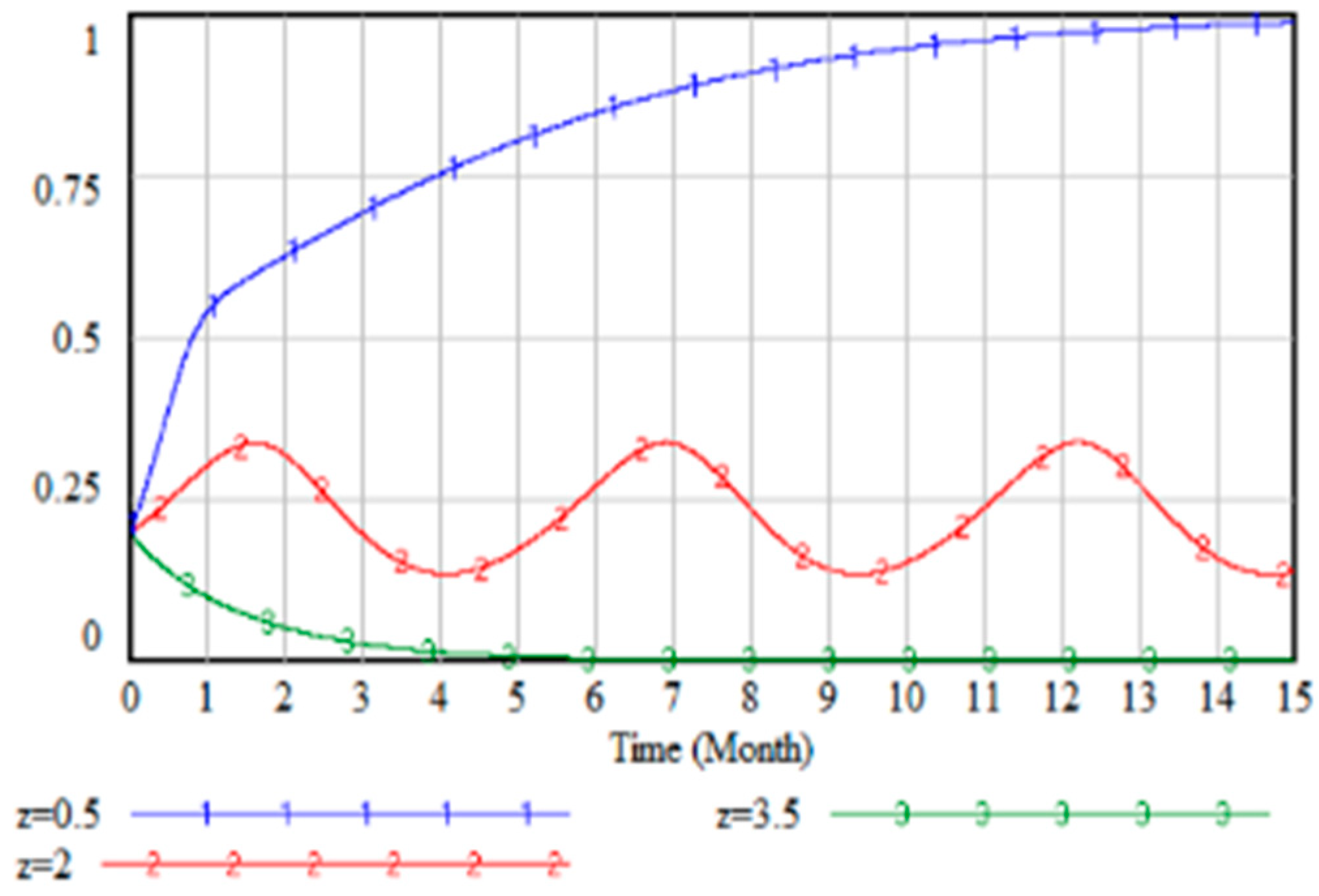
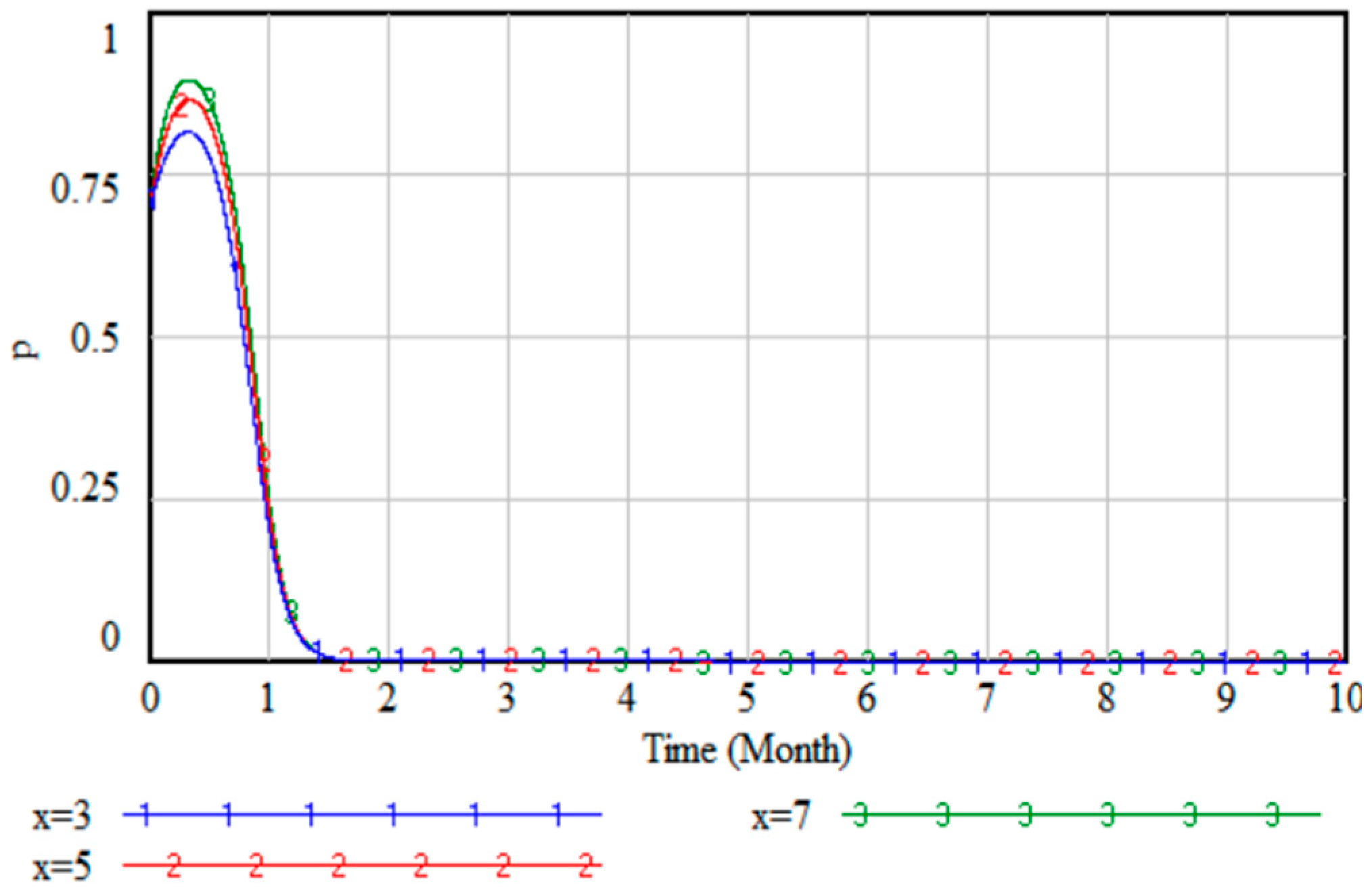
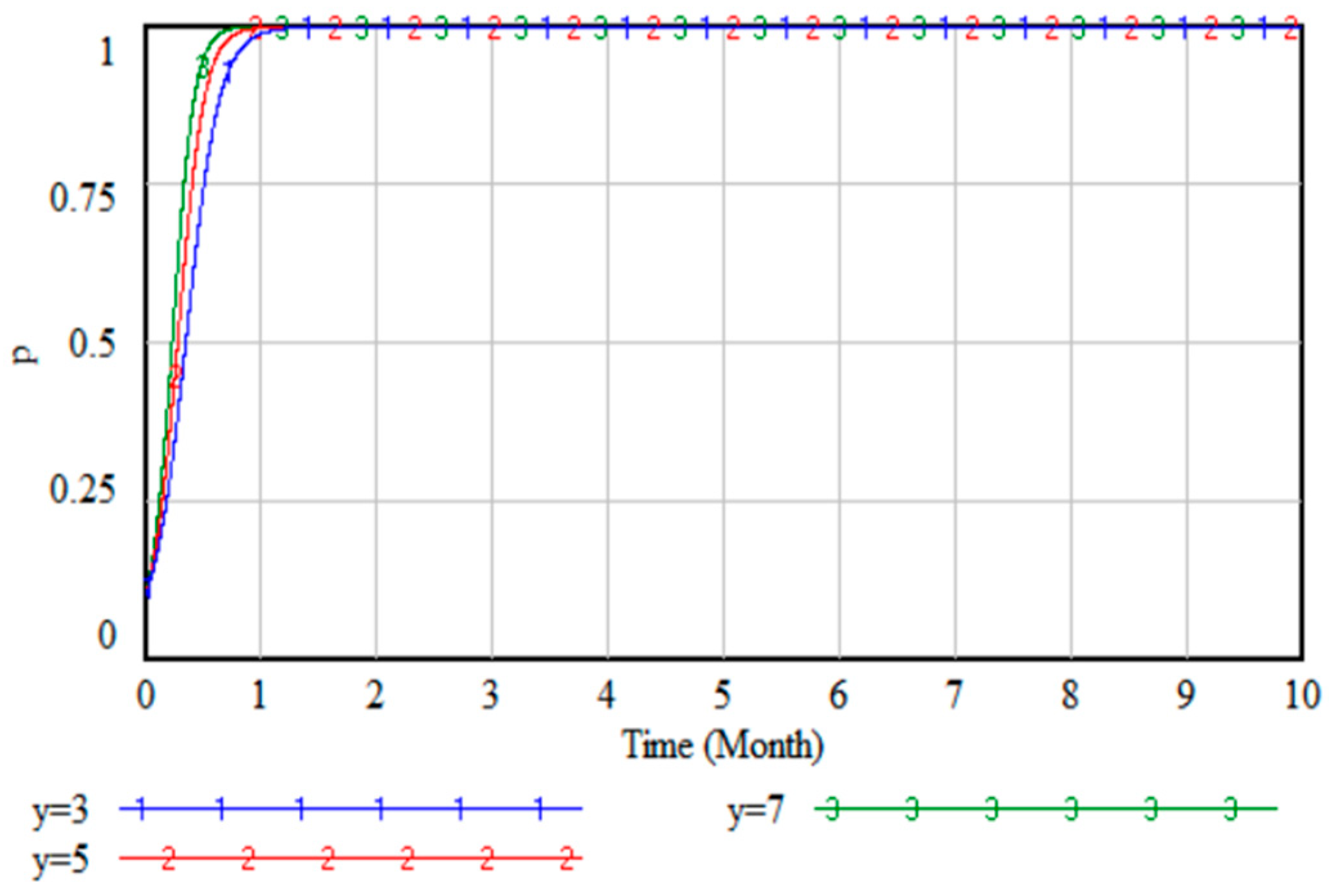
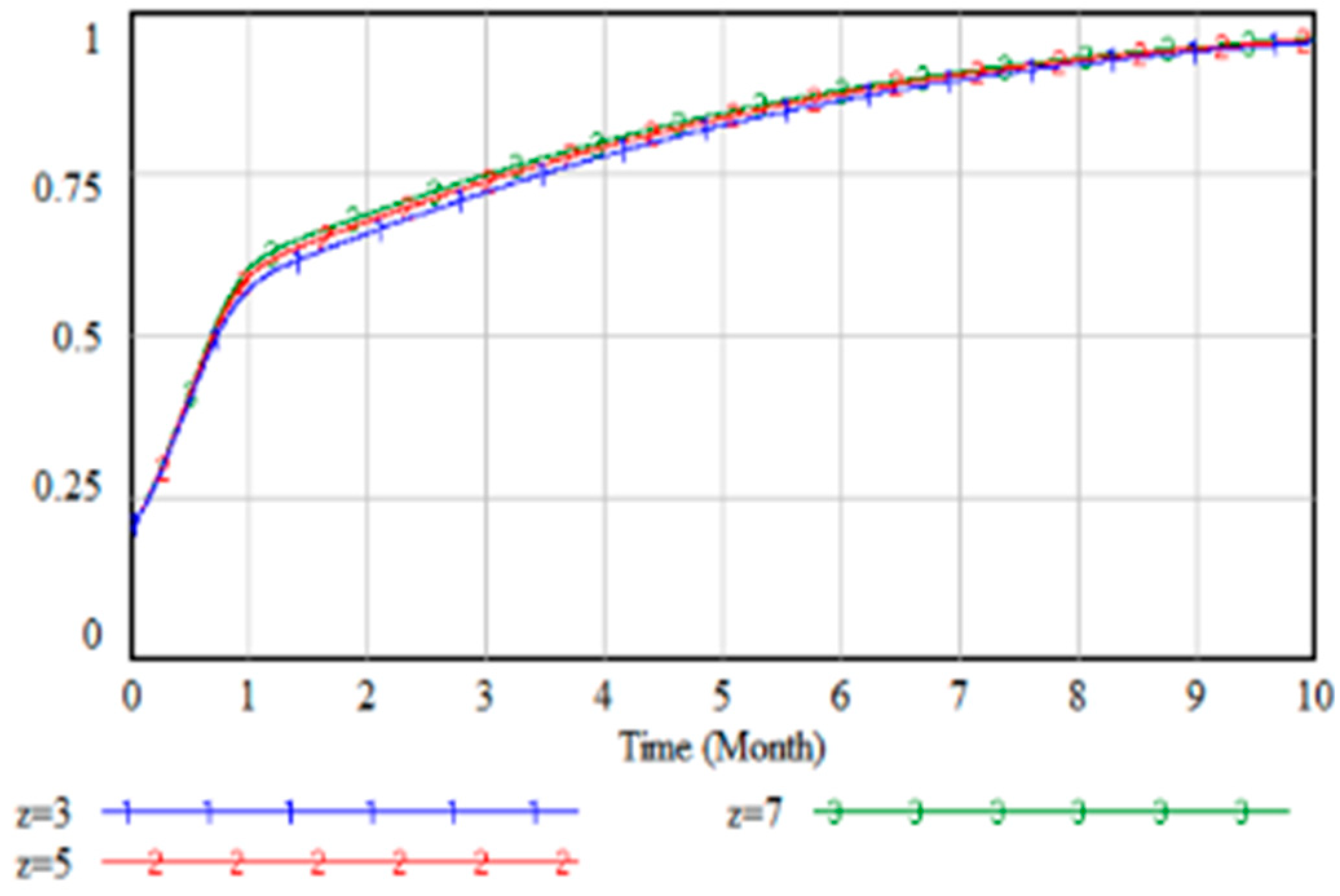
| Symbols | Meaning |
|---|---|
| L | Fines deducted by the government from enterprises producing FVs. |
| S | Government incentives for enterprises producing NEVs. |
| M | Oversight costs incurred by the government. |
| G | Costs of losses due to lack of government oversight. |
| N | Government right-of-way costs. |
| C1 | The expense of producing FVs for logistics vehicle enterprises. |
| C1 + ΔC | The expense of producing NEVs for logistics vehicle enterprises. |
| R1 | Costs of purchasing FVs for logistics enterprises. |
| R1 + ΔR | The expense of purchasing NEVs for logistics enterprises. |
| S1 | Logistics vehicle enterprises to produce NEVs earned positive points for trading revenue. |
| S2 | The expense of purchasing positive credits for the production of FVs by logistics vehicle enterprises. |
| Q1 | Benefits of using FVs in logistics enterprises. |
| Q1 + ΔQ | Benefits for logistics enterprises using NEVs. |
| D | Conversion of right-of-way acquired by logistics enterprises using NEVs into indirect benefits. |
| K | The cost savings due to scale production are K. |
| x | The likelihood that the government elects to monitor. |
| y | The likelihood of logistics vehicle enterprises deciding to manufacture NEVs. |
| z | The probability of logistics enterprises deciding to use NEVs. |
| Logistics Vehicle Enterprise | Government | |||
|---|---|---|---|---|
| Supervise (x) | Not Supervise (1 − x) | |||
| Logistics Enterprise | ||||
| Use NEV (z) | Use FV (1 − z) | Use NEV (z) | Use FV (1 − z) | |
| Produce NEV(y) | −S − M − N | −S − M − N | 0 | −G |
| S + S1 + (R1 + ΔR − (C1 + ΔC) | S(C1 + ΔC) + S1 | S1 + (R1 + ΔR) − (C1 + ΔC) | S1 − (C1 + ΔC) | |
| Q1 + ΔQ − (R1 + ΔR) + D − K | Q1 − R1 | (Q1 + ΔQ) − (R1 + ΔR) − K | Q1 − R1 | |
| Produce FV(1 − y) | L − M − N | L − M − N | 0 | −G |
| −C1 − S2 − L | R1 − C1 − S2 − L | −C1 − S2 | R1 − C1 − S2 | |
| Q1 + ΔQ − (R1 + ΔR) + D | Q1 − R1 | (Q1 + ΔQ) − (R1 + ΔR) | Q1 − R1 | |
| Fς | |||
|---|---|---|---|
| (2x − 1)(M − L − G + N + Gz + Ly + Sy) | |||
| x (x − 1)(L + S) | −(2y − 1)(S1 − R1 − ΔC + S2 + Lx + Sx + 2R1z + ΔRz) | ||
| Gx(x − 1) | −y (2R1 + ΔR)(y − 1) | ||
| Balance Point | The Eigenvalue λ1 | The Eigenvalue λ2 | The Eigenvalue λ3 |
|---|---|---|---|
| E1 (0, 0, 0) | G + L − M − N | S1 − R1 − ΔC + S2 | ΔQ − ΔR |
| E2 (1, 0, 0) | M − L − G + N | L − ΔC − R1 + S + S1 + S2 | D + ΔQ − ΔR |
| E3 (0, 1, 0) | G − M − N − S | ΔC + R1 − S1 − S2 | ΔQ − K − ΔR |
| E4 (0, 0, 1) | L − M − N | R1 − ΔC + ΔR + S1 + S2 | ΔR − ΔQ |
| E5 (1, 1, 0) | M − G + N + S | ΔC − L + R1 − S − S1 − S2 | D − K + ΔQ − ΔR |
| E6 (1, 0, 1) | M − L + N | L − ΔC + R1 + ΔR + S + S1 +S2 | ΔR − ΔQ − D |
| E7 (0, 1, 1) | −M − N − S | ΔC − R1 − ΔR − S1 − S2 | K − ΔQ + ΔR |
| E8 (1, 1, 1) | M + N + S | ΔC − L − R1 − ΔR − S − S1 − S2 | K − D − ΔQ + ΔR |
| Balance Point | The Eigenvalue λ1 | The Eigenvalue λ2 | The Eigenvalue λ3 | Eigenvalues Positive and Negative | Stability |
|---|---|---|---|---|---|
| E1 (0, 0, 0) | G + L − M − N | S1 − R1 − ΔC + S2 | ΔQ − ΔR | (*, *, +) | precarious |
| E2 (1, 0, 0) | M − L − G + N | L − ΔC − R1 + S + S1 + S2 | D + ΔQ − ΔR | (*, *, +) | precarious |
| E3 (0, 1, 0) | G − M − N − S | ΔC + R1 − S1 − S2 | ΔQ − K − ΔR | (*, *, *) | inconclusive |
| E4 (0, 0, 1) | L − M − N | R1 − ΔC + ΔR + S1 + S2 | ΔR − ΔQ | (*, +, −) | saddle point (math.) |
| E5 (1, 1, 0) | M − G + N + S | ΔC − L + R1 − S − S1 − S2 | D − K + ΔQ − ΔR | (*, *, *) | inconclusive |
| E6 (1, 0, 1) | M − L + N | L − ΔC + R1 + ΔR + S + S1 + S2 | ΔR − ΔQ − D | (*, +, −) | saddle point (math.) |
| E7 (0, 1, 1) | −M − N − S | ΔC − R1 − ΔR − S1 − S2 | K − ΔQ + ΔR | (−, −, *) | inconclusive |
| E8 (1, 1, 1) | M + N + S | ΔC − L − R1 − ΔR − S − S1 − S2 | K − D − ΔQ + ΔR | (+, −, *) | saddle point (math.) |
| Parameter | Value | Parameter | Value |
|---|---|---|---|
| L | 1 | ΔR | 0.5 |
| S | 0.5 | S1 | 3 |
| M | 10 | S2 | 2 |
| G | 20 | Q1 | 10 |
| N | 5 | ΔQ | 1 |
| C1 | 2 | D | 2 |
| ΔC | 0.5 | K | 0.1 |
| R1 | 2.2 |
Disclaimer/Publisher’s Note: The statements, opinions and data contained in all publications are solely those of the individual author(s) and contributor(s) and not of MDPI and/or the editor(s). MDPI and/or the editor(s) disclaim responsibility for any injury to people or property resulting from any ideas, methods, instructions or products referred to in the content. |
© 2025 by the authors. Licensee MDPI, Basel, Switzerland. This article is an open access article distributed under the terms and conditions of the Creative Commons Attribution (CC BY) license (https://creativecommons.org/licenses/by/4.0/).
Share and Cite
Hai, X.; Ma, C.; Zhao, C. New Energy Logistics Vehicle Promotion: A Tripartite Evolutionary Game Perspective. Sustainability 2025, 17, 8164. https://doi.org/10.3390/su17188164
Hai X, Ma C, Zhao C. New Energy Logistics Vehicle Promotion: A Tripartite Evolutionary Game Perspective. Sustainability. 2025; 17(18):8164. https://doi.org/10.3390/su17188164
Chicago/Turabian StyleHai, Xiaowei, Chunye Ma, and Chanchan Zhao. 2025. "New Energy Logistics Vehicle Promotion: A Tripartite Evolutionary Game Perspective" Sustainability 17, no. 18: 8164. https://doi.org/10.3390/su17188164
APA StyleHai, X., Ma, C., & Zhao, C. (2025). New Energy Logistics Vehicle Promotion: A Tripartite Evolutionary Game Perspective. Sustainability, 17(18), 8164. https://doi.org/10.3390/su17188164





